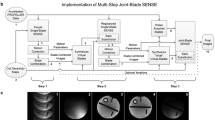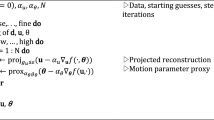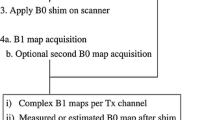Abstract
While some MRI systems offer a “pause” function, combining it with the PROPELLER method for image quality improvement remains underexplored. This study investigated whether repositioning the head after pausing during PROPELLER imaging enhances image quality. All brain phantom images in this study were obtained using a 3.0 T MRI and acquired using the fast spin-echo T2WI-based PROPELLER with motion correction. By combining the angle of rotational motion of the head phantom and the number of repositioning after a pause, two studies including seven trials were performed. Increasing the rotation angle decreased the image quality; however, pausing the image and repositioning the head phantom to the original angle improved the image quality. A similar result was obtained by repositioning the angle closer to its original angle. Experiments with multiple head movements showed that pausing the scan and repositioning the phantom with each movement improved image quality.






Similar content being viewed by others
References
Pipe JG. Motion correction with PROPELLER MRI: application to head motion and free-breathing cardiac imaging. Magn Reson Med. 1999;42:963–9.
Forbes KP, Pipe JG, Bird CR, Heiserman JE. PROPELLER MRI: clinical testing of a novel technique for quantification and compensation of head motion. J Magn Reson Imaging. 2001;14:215–22.
Deng J, Miller FH, Salem R, Omary RA, Larson AC. Multishot diffusion-weighted PROPELLER magnetic resonance imaging of the abdomen. Invest Radiol. 2006;41:769–75.
Hirokawa Y, Isoda H, Maetani YS, Arizono S, Shimada K, Okada T, et al. Hepatic lesions: improved image quality and detection with the periodically rotated overlapping parallel lines with enhanced reconstruction technique–evaluation of SPIO-enhanced T2-weighted MR images. Radiology. 2009;251:388–97.
Hirokawa Y, Isoda H, Maetani YS, Arizono S, Shimada K, Togashi K. Evaluation of motion correction effect and image quality with the periodically rotated overlapping parallel lines with enhanced reconstruction (PROPELLER) (BLADE) and parallel imaging acquisition technique in the upper abdomen. J Magn Reson Imaging. 2008;28:957–62.
Ohgiya Y, Suyama J, Seino N, Takaya S, Kawahara M, Saiki M, et al. MRI of the neck at 3 Tesla using the periodically rotated overlapping parallel lines with enhanced reconstruction (PROPELLER) (BLADE) sequence compared with T2-weighted fast spin-echo sequence. J Magn Reson Imaging. 2010;32:1061–7.
Chou M-C, Huang T-Y, Chung H-W, Hsieh T-J, Chang H-C, Chen C-Y. Q-ball imaging with PROPELLER EPI acquisition. NMR Biomed. 2013;26:1723–32.
Hahn S, Yi J, Lee H-J, Lee Y, Lee J, Wang X, et al. Comparison of deep learning-based reconstruction of PROPELLER Shoulder MRI with conventional reconstruction. Skeletal Radiol. 2023;52:1545–55.
Niitsu M, Saruya S, Sakaguchi K, Watarai K, Yoneyama M, Katsumata Y, et al. Motion-robust MR imaging of the shoulder using compressed SENSE MultiVane. Eur J Radiol Open. 2022;9: 100450.
Czyzewska D, Sushentsev N, Latoch E, Slough RA, Barrett T. T2-PROPELLER compared to T2-FRFSE for image quality and lesion detection at prostate MRI. Can Assoc Radiol J. 2022;73:355–61.
Meier-Schroers M, Kukuk G, Homsi R, Skowasch D, Schild HH, Thomas D. MRI of the lung using the PROPELLER technique: artifact reduction, better image quality and improved nodule detection. Eur J Radiol. 2016;85:707–13.
Forbes KP, Pipe JG, Karis JP, Farthing V, Heiserman JE. Brain imaging in the unsedated pediatric patient: comparison of periodically rotated overlapping parallel lines with enhanced reconstruction and single-shot fast spin-echo sequences. AJNR Am J Neuroradiol. 2003;24:794–8.
Forbes KP, Pipe JG, Karis JP, Heiserman JE. Improved image quality and detection of acute cerebral infarction with PROPELLER diffusion-weighted MR imaging. Radiology. 2002;225:551–5.
Lavdas E, Mavroidis P, Kostopoulos S, Glotsos D, Roka V, Topalzikis T, et al. Improvement of image quality using BLADE sequences in brain MR imaging. Magn Reson Imaging. 2013;31:189–200.
Kraus MS, Coblentz AC, Deshpande VS, Peeters JM, Itriago-Leon PM, Chavhan GB. State-of-the-art magnetic resonance imaging sequences for pediatric body imaging. Pediatr Radiol. 2023;53:1285–99.
Saju G, Li Z, Mao H, Liu T, Chang Y. Suppressing image blurring of PROPELLER MRI via untrained method. Phys Med Biol. 2023. https://doi.org/10.1088/1361-6560/acebb1.
Saleh M, Virarkar M, Javadi S, Mathew M, Vulasala SSR, Son JB, et al. A feasibility study on deep learning reconstruction to improve image quality with PROPELLER acquisition in the setting of T2-weighted gynecologic pelvic magnetic resonance imaging. J Comput Assist Tomogr. 2023. https://doi.org/10.1097/RCT.0000000000001491.
Liu Z, Zhang Z, Ying K, Yuan C, Guo H. Improved motion correction in PROPELLER by using grouped blades as reference. J Magn Reson Imaging. 2014;39:700–7.
Pipe JG, Gibbs WN, Li Z, Karis JP, Schar M, Zwart NR. Revised motion estimation algorithm for PROPELLER MRI. Magn Reson Med. 2014;72:430–7.
Tamhane AA, Arfanakis K. Motion correction in periodically-rotated overlapping parallel lines with enhanced reconstruction (PROPELLER) and turboprop MRI. Magn Reson Med. 2009;62:174–82.
GEHealthCare [Internet]. Accessed 25 Aug 2023. https://www.gecares.com/s/?language=en_US
Saotome K, Matsushita A, Matsumoto K, Kato Y, Nakai K, Murata K, et al. A brain phantom for motion-corrected PROPELLER showing image contrast and construction similar to those of in vivo MRI. Magn Reson Imaging. 2017;36:32–9.
Kim HG, Choi JW, Yoon SH, Lee S. Image quality assessment of silent T2 PROPELLER sequence for brain imaging in infants. Br J Radiol. 2018;91:20170680.
AfBurén S, Kits A, Lönn L, De Luca F, Sprenger T, Skare S, et al. A 78 seconds complete brain MRI examination in ischemic stroke: a prospective cohort study. J Magn Reson Imaging. 2022;56:884–92.
Oura D, Gekka M, Morishima Y, Niiya Y, Ihara R, Ebina T, et al. Simultaneous depiction of clot and MRA using 1 min phase contrast angiography in acute ischemic patients. Magn Reson Imaging. 2022;93:149–56.
Kubota Y, Yokota H, Sakai T, Yoneyama M, Ohira K, Uno T. Clinical feasibility of single-shot fluid-attenuated inversion recovery with wide inversion recovery pulse designed to reduce cerebrospinal fluid and motion artifacts for evaluation of uncooperative patients in acute stroke protocol. J Magn Reson Imaging. 2021;53:1833–8.
Acknowledgements
The authors thank Ms. Kanae Moriyama and Mr. Kenichi Kazahari (GE Healthcare) for providing information on the PROPELLER technique. We also thank Editage (www.editage.com) for the English language editing.
Funding
This paper is part of the results obtained with the support of JMRTS (Japan Authorizes the Organization of Magnetic Resonance Technological Specialists).
Author information
Authors and Affiliations
Contributions
KS, KM, and YK contributed to the study design, data collection, phantom set making, algorithm construction, and the writing and editing of the article; YO, NM, TH, and HT carried out the data collection, and the reviewing and editing of the article; TY contributed to the analysis in the image quality assessment; All the authors read and approved the final manuscript.
Corresponding author
Ethics declarations
Conflict of interest
The authors declare that they have no competing interests.
Additional information
Publisher's Note
Springer Nature remains neutral with regard to jurisdictional claims in published maps and institutional affiliations.
About this article
Cite this article
Saotome, K., Matsumoto, K., Kato, Y. et al. Improving image quality using the pause function combination to PROPELLER sequence in brain MRI: a phantom study. Radiol Phys Technol (2024). https://doi.org/10.1007/s12194-024-00784-z
Received:
Revised:
Accepted:
Published:
DOI: https://doi.org/10.1007/s12194-024-00784-z




